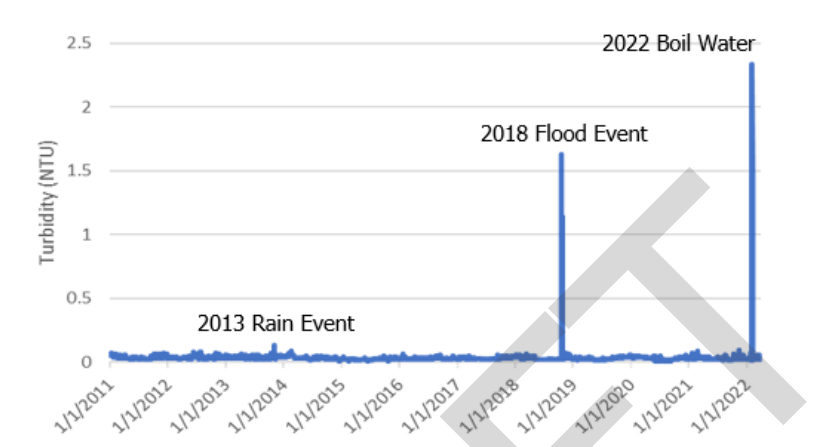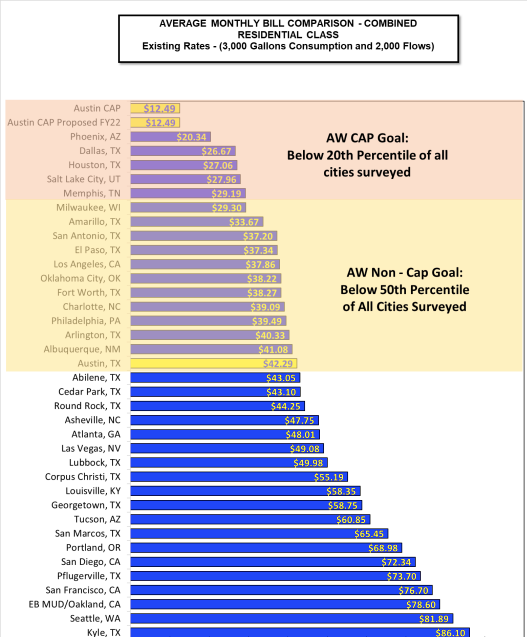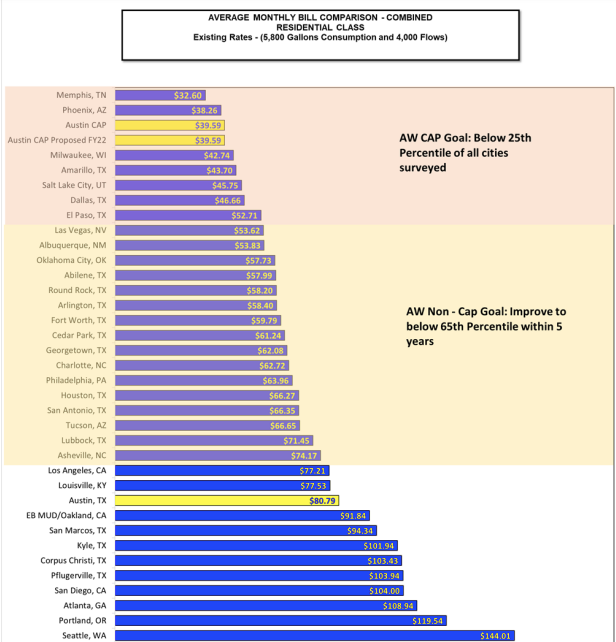How much should Austin pay for good water?

The recently-released audit of Austin Water, which was prompted by last year's boil water notice, offers a glimpse of the staffing challenges that threaten the operations of every city government service. It should serve as a wake-up call for City Council members about the need to increase revenue if we hope to provide high-quality public services.
The roughly 60-page report, authored by the the University of Texas Center for Water and the Environment, happily concluded that the utility's infrastructure and equipment was largely in good shape. Only twice in the past decade has the water exceeded the maximum turbidity level (0.3 NTU) set by state standards: during the massive flood in 2018 and of course last year's boil water notice, which was due entirely to human error.

There were three other incidents listed in the scope of the audit: the response to Winter Storm Uri; the 2019 Zebra Mussels problem; and an issue in early 2020 with fire foam getting into the water system in South Austin, which was apparently the fire dept's fault.
The audit didn't assign much blame to AW in any of those events and appeared satisfied with the utility's ongoing efforts to improve resiliency in the wake of the winter storm.
However, it highlighted big problems related to staffing and management. These issues helped explain the water boil a year ago, which was attributed to a mistake made by a couple of employees, and they could cause future problems if they're not addressed.
Who's in charge?
On one hand, the audit suggests there's one person with way too much on their plate: the utility's assistant director for operations (OAD) oversees 16 division managers, to whom 70% of the utility's workforce answers. No other assistant director oversees more than four division managers. Staff at the Ulrich plant reported rarely having contact with him:
Currently, the span of control of the OAD is excessively broad and appears to limit the direct interactions the Assistant Director has with plant staff. During interviews, plant staff reported that the OAD visited the plant only twice a year even though the OAD’s calendar indicated that he visited quarterly. Whether the number of annual visits was two or four, the staff reported wanting the OAD to be more visible.
And yet, lower in the hierarchy, the audit highlighted the opposite problem: a lack of centralized authority. The audit found that the Ulrich Plant in South Austin, the source of the problem that caused last year's boil notice, has two superintendents "who do not get along well" and "frequently have different approaches to management."
Staff interviews repeatedly and specifically mentioned that this adversely impacts the work environment at Ullrich. There appears to be no overarching direction to staff at the plant, with the accompanying issue that no single set of standards is used to either reward staff or hold them accountable. Strong division amongst the staff supporting one or the other of the superintendents’ approaches to the work is apparent, which disrupts staff teams who are “taking sides.” Ultimately, this results in the inability of the plant staff to operate as a team, with the work not being well directed and unacceptable behaviors going uncorrected.
Similarly, the report authors encountered a variety of responses from staff when they asked about standard operating procedures.
Plant operations and maintenance staff reported that it is generally difficult to access the existing SOPs, and as a consequence, the SOPs may not be utilized as needed. Multiple plant staff indicated that they know of only a few SOPs; others indicated that the SOPs reside in an electronic O&M manual. This is contradictory to what we heard from the executive level, which is that AW has invested in an online O&M Manual that is available to staff.
There are apparently 80 standard operating
Finally, unlike Austin Energy, Austin Water doesn't report directly to the city manager. Even weirder, its report is to the Assistant City Manager for Mobility.
"We're not sure that's the best point of report for them," Lynn Katz, the director for the UT Center for Water and the Environment, told the City Council Audit & Finance Committee on Jan. 18.
The audit recommends putting AW on the same level as the other large utility, with a direct line to City Manager Spencer Cronk.
Although it responded favorably to most of the recommendations in the audit, the utility pushed back on establishing a direct report between the utility and the city manager, noting that AW had only recently transitioned to the mobility portfolio (as part of a broader overhaul of city management five years ag0). Curiously, it did not offer any arguments for why the current arrangement is best, but pointed out that similar arrangements are the norm around the country. It furher noted that, whatever the reporting structure, "all city operations report through and are accountable to the city manager."
They need pay raises
Management reforms will only get Austin Water so far. The 30% vacancy rate at the Ulrich Plant has a lot to do with compensation.
Austin Water is hardly the only utility facing recruitment challenges; the graying workforce is a big issue across the water industry. But like other public sector employers in town, Austin Water faces the additional challenges of operating in a particularly strong job market and a particularly expensive housing market, both of which put more pressure on it to raise wages to attract and retain skilled labor.
At the very least, however, AW should be able to compete with neighboring water utilities and other public sector jobs. And yet:
Some upper-level operators have left the utility for jobs in neighboring communities where salaries are at least a dollar more an hour. Several interviewees reported that they routinely receive attractive offers from other municipalities. In addition, there is no mechanism for performance-based salary increases, which may blunt enthusiasm for improved staff performance.
And yet, AW has struggled to convey the importance of pay raises to the city's HR department, which is responsible for defining salary ranges.
Some of these concerns are governed by decisions made by corporate Human Resources, including determinations not to implement approximately 50 percent of the salary adjustments requested by AW in association with a recent market study.
This was also a bummer:
At the time interviews were conducted, operators were aware that over the past year and a half, a market study was conducted to determine whether changes should be made in operator salaries. At the same time, the project team was told that the market study was currently in the hands of the City of Austin Human Resources and had been in their hands for several months.
One wonders if this may also be a symptom of AW's lack of direct report to the city manager. If it's overseen by the assistant city manager for mobility, who tends to be someone focused on transportation, it can expect to be overlooked.
Getting to pay raises
Dealing with the compensation issue at Austin Water is much simpler than addressing it for services that are funded by the general fund, such as police, fire, EMS and parks. That's because the GF depends on sales and property tax, and the state imposes strict limits on the city's ability to increase property taxes.
Austin Water's revenue issue is solved simply by raising rates. It and it probably should do so. It hasn't raised rates in five years.
As is the case for Austin Energy (albeit less so as of a month ago), AW's rates are structured to reward those who conserve. It's a good deal for the thriftiest and a bad deal for the thirstiest. (Or rather, those with the thirstiest pools and landscapes)
For instance, as shown below, a residential customer who uses 3,000 gallons a month pays less in Austin than in Round Rock or Pflugerville. Those who qualify, based on income or enrollment in certain public assistance programs, in the Customer Assistance Program (CAP), pay even less.

However, when it comes to heavy water consumers, our neighbors to the north pay less:

What pay problem?
When I reached out to the utility to see if rate increases might be contemplated to address the staffing issues, the statement I got in response didn't appear to acknowledge the compensation problems. Here's what I received from a spokesperson:
The AW External Review highlighted the challenges of compensation and staff retention faced by Austin Water. These are primarily issues related to filling existing vacant positions, rather than an unmet need for new positions. As Austin has grown in recent years, Council has supported appropriate staffing increases for Austin Water to serve a growing City. Austin Water is still working with the City Manager to determine if any new positions are warranted from the findings of the External Review; however, any such new positions are not expected to drive a rate increase.
But might their struggle to fill those vacancies be due to poor pay, a problem that could be solved with slightly higher water rates?
Whatever. They don't want to advertise a rate increase before they have to, I get it. But it's a weird flex considering that just last July AW leaders said that the utility likely couldn't go another two years without increasing rates.
I just hope we're not being pennywise and pound foolish. Most Austinites would gladly pay a couple extra bucks a month for clean and reliable water.





